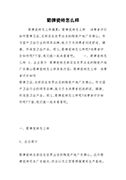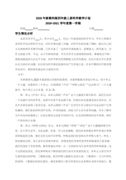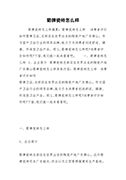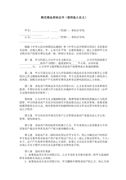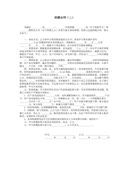小学第6册英语4单元6课时教案(通用13篇)三年级英语教案
小学第6册英语4单元6课时教案(通用13篇)
小学第6册英语4单元6课时教案 篇1
第四课时
一、教学重点:
动词短语的ing 形式:listening to music, washing clothes, cleaning the room, writing a letter, writing an e-mail。
二、教学难点:
以不发音的字母e结尾的动词ing 形式的变化。
三、课前准备:
教师准备let’s chant 部分的插图,let’s start部分的挂图。
教师准备本课时的五张词卡和图片以及以前所学的词卡和图片。
教师和学生都准备一张家庭成员各自做事的图片或照片。
教师准备录音机和录音带。
四、教学过程:
1、warm up (热身)
活动一:说说唱唱
教学参考时间:1—2分钟
教师播放本单元第一页上歌谣的录音,让学生跟录音说说唱唱。
活动二:口语练习
教学参考时间:2—3 分钟
鼓励学生结合a read and write 部分 的内容,模拟打电话邀请一个人去某地。如:
----hello. this is tom. can i speak to john?
----hi. it’s john here.
----what are you doing, john?
----i am reading a book. and you?
----i am watching tv. it’s sunday. do you want to go to the bookstore?
----sure. what time?
----2:00 pm.
----ok. see you later.
----see you.
2、review (复习)
活动三:动作接力
教学参考时间:2—3 分钟
教师准备所学动词短语的卡片。
让学生4人一组,将学生分成若干组。
每个小组的第一个学生看同一个动词短语,如:reading a book ,然后不出声音“说”给第二个同学。
每组第二个同学根据口型,猜短语,并做出适当的动作。
每组第三个同学根据动作说短语,如:reading a book reading a book.
每组第四个同学说出完整句:i am reading a book. 最先说出句子的小组获胜。
继续进行此活动,4人一组的顺序可让学生自行调整,也可依次后推。根据时间状况,确定游戏次数。
3、presentation (呈现新知)
活动四:新课学习
教学参考时间:6—7 分钟
教师在 “动作接力”的最后,出示所有单词卡片,学生认读词语。教师注意对比动词原形和动词的ing 形式,从而使学生熟练的掌握现在进行时的用法。
教师出示本课时第一个动词短语的图片,并告诉学生he ‘s listening to music. 教师板书并带读。随后,让学生说说listening to music 的原形listen to music,再次强调、对比动词原形和动词的ing 形式,使学生熟练的掌握现在进行时的用法。
教师出示“clean the room ”的图片,带读动词短语的原形。随后,教师提问:what’s he doing? 让学生回答:he’s cleaning the room.
教师作洗衣服的动作,引出短语“washing clothes”。学习并操练句型问答。同时,教师引导学生复习wash构成的短语,如:washing dishes, washing my face …。注意,短语与句子不脱离,把短语放在句子中练习。
采用同样的方法或描述的方法学习writing a letter, writing an e-mail 。教师作写字的动作,边做边说write ,并告诉学生以不发音的字母e结尾的动词ing 形式在变化时,要去e再加ing 。这是本课时的难点,教师要在正确示范的基础上指导学生熟悉掌握。随后,教师进一步讲解writing a letter, writing an e-mail,学生练习。
教师播放let’s learn 部分的录音,学生指图、听录音认读短语。
活动五:高低音
教学参考时间:1—2分钟
教师指着黑板上的图片带读短语,如果教师声调高,学生就大声跟读,反之则不跟读。
教师让能力强的学生带读词卡,方法同上。带读的同学声调高,学生就大声跟读,反之则不跟读。
游戏的最后,教师操练句子,如:my father is writing an e-mail.
6、板书设计
unit 4 what are you doing?(iv)
listening to music, washing clothes, cleaning the room, writing a letter, writing an e-mail
(每个词语配有图片)
小学第6册英语4单元6课时教案 篇2
第五课时
一、教学重点:
打电话用语,如:“can i speak to …? this is …. please hold on.”。
表述他人正在做某事的句子he/she is…-ing.
二、教学难点:
打电话用语。
三、课前准备:
教师准备一部电话机。
教师准备b let’s talk 部分的挂图。
教师准备录音机和录音带。
每四名学生准备10张左右的动作图片和短语卡片。
四、教学过程:
1、warm up (热身)
活动一: 歌谣对答
教学参考时间:1—2分钟
教师播放第49页的歌谣,师生采用对答形式说唱。
再次播放,采用生生对答形式。
a: grandma is cooking.
b: cooking noodles. (其它各句形式同本句)
活动二:口语练习
教学参考时间:1—2 分钟
教师可以拿出几名学生的家庭相册进行提问。如:
who’s the girl/boy?
who’s that wan/woman?
what is he/she doing?
how many people are there in the picture?
what is this?
2、review (复习)
活动三:词语连线
教学参考时间:3—4 分钟
教师在黑板上写好下面两列单词,让学生连线并正确读出短语。
listening to a letter
washing music
writing clothes
cleaning an e-mail
writing the room
watch the phone
answering the dishes
doing tv
3、presentation (呈现新知)
活动四:听听做做
教学参考时间:2—3 分钟
在学生复习动词-ing形式的基础上,做“listen and tick”的练习。学生听录音,做练习。录音内容如下:
hello.
hello. this is john. can i speak to mike, please?
sure. he’s doing homework. please hold on.
thank you.
mike, there is a call for you.
thank you.
what is mike doing?
学生根据所听内容选择并划“√”。
学生试着跟读。
活动五:搭配游戏
教学参考时间:3—4 分钟
教师让学生打开书第50页,做let’s play部分的活动。教师先随意将人名与动词短语的-ing形式连线, 然后根据连线情况进行问答,如:what is chen jie doing? 学生回答she’s …. 教师先带领学生练习游戏,给学生作示范。
两人一组,随意将人名与动词短语的-ing形式一一连线,然后根据各自的连线情况进行问答。
活动六:猜一猜
教学参考时间:2—3 分钟
教师拿出let’s talk部分的挂图,但要将四幅图分别用四张白纸遮盖好,问学生:what is she doing? ,学生猜对一个,教师就把这张图上的纸拿掉,直到学生全部猜出为止。
五、板书设计
unit 4 what are you doing?(v)
can i speak to…?
this is ….
please hold on.
there’s a call for you.
小学第6册英语4单元6课时教案 篇3
第六课时
教学重点:
1.能够听说读写四会句子:what’s the date? june 9th. is her birthday in june? yes.
2.能够听说认读read and write部分的对话,能回答对话后的问题并书写答句。
3.能够听懂和理解story time中的故事。
教学难点:
read and write部分的对话,因为语言知识含量较大。
课前准备:
1.教师准备教学过程中所需要的图片、声音和课件。
2.教师准备录音机及录音带。
教学过程:
warm—up(热身)
活动一:举手说词
教学参考时间:3分钟
① 教师给出一个单词,如may,并举起左手和右手。教师举右手,学生要说出下一个月份june;举左手学生则要说出上一个月份april。
② 请若干名学生到前面带领学生做游戏。
活动二:抽纸条,说句子
教学参考时间:3分钟
① 教师准备12个月份的纸条,放在一个盒子里,再准备四季的纸条放在另一个盒子里。
② 游戏开始时,一名学生从两个盒子里各抽取一张纸条,连起来说一个句子。如果这个句子符合事实,如:“august is summer.”这组学生就取得了胜利,反之则遭淘汰。
presentation(新课呈现)
活动三:读读写写read and write
教学参考时间:8分钟
① 学生看33页的图,教师请学生说一说“what is zoom doing?”。
② 学生看图完成短文的填空。
③ 教师播放短文录音,学生根据录音内容核对自己的答案。
④ 教师请学生说一说、拼一拼所填的单词,其他同学判断对错。
⑤ 教师再次播放录音,学生逐句跟读,而后请学生朗读短文。
活动四:story time
教学参考时间:8分钟
① 学生看图37页,教师播放故事两遍。
② 请学生讲一讲每幅图的意思,用中文或英文都可。
③ 教师播放录音,学生跟读,遇到学生不理解的句子教师讲解。
④ 学生分角色朗读课文。
let’s play(趣味操练)
活动五:bingo游戏
教学参考时间:5分钟
① 教师让学生按照书上的三条步骤去完成bingo游戏板,而后教师读序数词,学生划掉所听到的单词,横或竖成一线的学生可以大声喊“bingo”。
② 继续游戏,直至大部分学生都喊“bingo”。
活动六:演一演
教学参考时间:5分钟
① 学生以小组为单位表演故事。
② 教师拿出事前准备的头饰,请若干小组到台前表演。
consolidation and extension(巩固与扩展)
活动七:task time
教学参考时间:5分钟
① 教师请学生说一说12个月历中的节日。
② 让学生制作一个“a personal calendar”。
活动八:做一做
教学参考时间:3分钟
教师带领学生完成活动手册b部分中的第5题和第6题。
板书
unit3 my birthday
is grandma’s birthday in june? yes, it is.
what’s the date? june 9th.
教学反思:
本课时主要是复习,所以发挥学生的主体地位,让学生喜欢问什么就问什么,喜欢问谁就问谁。在轻松愉快地课堂气氛中巩固这个单元学习的所有内容。
小学第6册英语4单元6课时教案 篇4
lesson 3
teaching aims:
1. grasp four skilled sentences: “ when do you eat dinner? i eat dinner at 7:00 in the evening. when do you get up? i usually get up at 12:00 at noon.”
2. read part of pronunciation, know the pronunciation of “ai, ay, gr, gl”
key points:
grasp four skilled sentences.
know the pronunciation of “ai ay”
teaching aids:
1.pictures, tapes.
teaching steps:
step 1 warming up
1. perform part of let’s talk.
2. game:
3. short report: my day.
s1: when do you get up? s2: i usually get up at 6:30 on the morning.
s1: when do you go to school? s2: i often go to school at 7:40 on the morning.
ask some questions about the report.
step 2 presentation
1. game: what’s the truth?
present five sentences:
i get up at 5:00 am. i go to bed at 3:00 am.
i play sweep the floor at 11 pm. i eat dinner at 6:00 pm.
i wash the cloth at 4:00 pm. i cook the meals at 3:00 am.
get students find out which is wrong, and say the reason.
lead to “read and write”.
2. present four small pictures, introduce them first. get students read the text, ‘ finish the timetable.
listen to the tape and check it.
4. pronunciation
ai: mail, sail, tail, wait, paint,
ay: say, play, day, may, away, pay
gr: great, green, grass, gray, grandpa, grapes.
gl: glass, glow, glue, glove…
listen and try to remember.
5. tongue twist.
wait for the rain to paint a rainbow.
say that we may play today.
grandma gladly grows great green grapes.
step 3 consolidation and extension
1. perform: interview a doctor.
s: excuse me, can i ask you some questions?
d: sure.
s: what do you do?
d: i’m a doctor.
s: when do you eat dinner?
2. ex. on the activity book.
blackboard:
when do you eat dinner?
i eat dinner at 7:00 in the evening.
when do you get up?
i usually get up at 12:00 at noon.
thoughts after class:
教学反思:
发音的部分的句子比较难掌握,因此我不要求读得很快,但是要让学生能读出来,读准确。对于频度副词ofen usually sometimes的用法我用比赛造句的方式来巩固,要求一个句子一个意思用不同的副词有不同的意思,一个人一口气说出三个句子。
小学第6册英语4单元6课时教案 篇5
第二课时
教学重点:
1、学习询问她//它在做什么及回答:what is she/he/it doing? she /he /it is…
2、了解字母a和字母组合ar,sm, sl的发音规律。
教学难点:
1、句型:what is she/he /it doing? she/he/it is…
2、能够在实际情景中正确运用所学对话。
课前准备:
教师准备录音带和教学课件。
教师准备有关动物和动作的单词卡片。
教师准备pronunciation部分的挂图。
教学过程:
warm up ( 热身)
活动一:唱一唱
教学参考时间:2分钟
(1)教师放第四单元c部分的歌曲what are you doing?的录音,学生一起进行表演唱。
(2)教师放a部分的歌谣的录音,学生听录音,边做边有节奏地说唱。
活动二:做一做
教学参考时间:3分钟
(1)教师出示a部分let’s learn的图片,让学生扮演图中的小动物,分小组表演对话。
(2)让学生进行展示。look at..! it’s …! the … is….
2、presentation (新课呈现)
活动三:试一试
教学参考时间:5分钟
(1)教师出示a let’s learn部分的单词卡,让学生拼读单词,并用动作表示出中文意思。
(2)让学生看书,听录音完成listen and match 。
(3)教师核对答案。
(4)让学生模仿录音,做问答练习。
活动四:情景对话
教学参考时间:8分钟
(1)教师出示图片:在一个大森林里,一头大象在前面走,后面跟着一头小象在跑。教师让学生观看,提问:what do you see in the forest? 引导学生回答:i see two elephant.
(2)教师指着大象说:this is the mother elephant.提问:what is she doing?引导学生回答;she’s walking.教师再指着小象提问:what about the baby elephant? what is it doing?引导学生回答:it’s running.
(3)点击课件中的播放按钮,让学生听一听chen jie和amy的对话。
(4)让学生分别扮演chen jie和amy做对话练习。
5、板书
unit 5 look at the monkeys
what is she doing? she is …
a: a glass of ants are inside my pants.
what is he doing? he is…
ar: it’s hard to park a car on a star.
what is it doing? it is…
sm,sl: smart snails smile small slow smiles.
小学第6册英语4单元6课时教案 篇6
第六课时
一、教学重点:
从听、说、读、写四方面掌握本课粗体句型“ grandpa is writing a letter. brother is doing homework. mom is cooking dinner in the kitchen. he’s writing an e-mail in the study. ”
能够听懂、会说、认读read and write部分的内容。
二、教学难点:
接听电话的任务是本课时的难点。
“how’s everybody doing? just fine. ” 是新语言,教师应作必要的解释。
三、课前准备:
教师准备动词短语卡和拼图一张。
教师准备录音机和录音带。
学生准备家庭人员照片若干张。
四、教学过程:
1、warm up (热身)
活动一:口语练习
教学参考时间:1—2分钟
教师鼓励学生将所学知识综合在一起,编成对话或介绍图片等。如:
hello. this is tina.
hello. can i speak to mary, please?
she’s doing her homework. please hold on.
thank you.
mary, there’s a call for you.
活动二:歌谣演唱
教学参考时间:1—2 分钟
教师播放b部分的歌谣录音,师生共同跟录音演唱。
2、review (复习)
活动三:复习旧知
教学参考时间:3—4 分钟
教师找同学读读let’s talk部分的内容。
让学生表演let’s talk部分的对话。
让学生换上伙伴的名字或自己家庭成员进行对话。
3、presentation (呈现新知)
活动四: 读读贴贴
教学参考时间:2—3 分钟
教师出示短语卡片,全班学生齐读。之后,请第一组学生代表将短语卡贴到相应的动作图片下,贴的同时第一组其他组员共同说出一个句子,如:he’s writing an e-mail.,接着由第二组代表贴图说句子,第二组组员说句子,依此类推,直至各小组都进行过。
活动五: 加句子
教学参考时间:3—4 分钟
学生五至六人一组,第一个学生说一个描述家庭成员在做某事的句子,如:mom is cooking in the kitchen. ,第二个学生先重复前面学生说的句子,然后再说一个不同的句子,如:mom is cooking in the kitchen. dad is reading a newspaper in the study.,依此类推。
活动六:读读写写
教学参考时间:7—8 分钟
教师播放read and write部分的录音,学生认真听,之后凭借记忆复述听到的句子或词语。
教师再次播放,学生跟读。
教师问一名学生:how are you? ,学生作答后教师板书:how are you doing today? how are you? how are you doing? 用手势和动作告诉学生三个句子意思相同,并划个大括号,最后,板书 just fine. 。教师在用三种方法向学生提问:“how are you doing today? how are you? how are you doing?”引导学生回答:just fine. 。教师板书everybody 并带读,教师问一名学生:how’s everybody doing? 提示everybody一词的含义,引导学生理解,并作答。
在学生理解的基础上,教师请学生合上课本,判断下面句子的对错:
mom is cooking dinner in the kitchen.
dad is writing a letter in the study.
grandpa is reading newspaper.
the boy is doing homework.
brother is cleaning the room.
完成finish the sentences 的活动。
教师指导学生书写四会句子,看谁写得又快又好,包括:“ grandpa is writing a letter. brother is doing homework. mom is cooking dinner in the kitchen. he’s writing an e-mail in the study. ”。
小学第6册英语4单元6课时教案 篇7
unit3
第一课时
教学重点:
能够听、说、读、写12个月份,及其缩写形式。
能用“when is your birthday?”询问对方的生日,并能用“my birthday is in ….”来表达自己的月份。
能用英文表达一年中的四季,并了解四季的划分。
教学难点:
能正确朗读12个月份,并能默写。
能结合所学语言点开展对话。
课前准备:
1.教师准备教学过程中所需要的年历、声音和课件。
2.教师准备录音机及录音带。
四、教学过程:
warm—up(热身)
活动一:唱一唱
教学参考时间:3分钟
① 教师播放歌曲“what's your favourite season?”。
② 学生跟唱,边唱边作每个季节相应的动作。
活动二:说一说
教学参考时间:5分钟
① 教师将歌曲定格在春季的图片上,而后问学生“what season is it?”。学生回答“spring”,如果没有学生能答出,教师再次播放歌曲。
② 请学生用“i like spring/autumn …..”说一说自己喜欢什么季节。
presentation(新课呈现)
活动三:学一学
教学参考时间:7分钟
① 教师拿出事前准备的年历,逐月用英语介绍,让学生初步接触了解12个月份的英文表达方法。
② 教师翻到某一月,向学生介绍说:“my birthday is in ….”,并在当月画上一个大的生日蛋糕,让学生理解“birthday”的意思。而后询问学生:“when is your birthday?”。
③ 学生课件,教师点击12个月份的英文单词,播放其发音。学生可重点学习自己生日的月份,而后说一说:“my birthday is in ….”。
④ 教师再次播放单词录音,学生根据自己的情况或喜爱,重点学习三、四个月份。
⑤ 请若干名学生做小老师,教大家他会的月份,其他学生学习。
活动四:问一问
教学参考时间:5分钟
① 学生看课件,出示28页中的第一幅图(两个小男孩对话),教师指着黑皮肤的小男孩问:“do you want to know when his birthday is? please ask him.”。
② 教师鼓励学生用“when is your birthday?”来进行提问,当大部分学生都能提问后,教师点击小黑孩的对话窗,让学生听后回答。
③ 请学生问自己的好朋友,或是他不知道谁的生日去进行提问。
如:a: hello, jack. when is your birthday?
b: my birthday is in july. and you?
a: in april.
let’s play(趣味操练)
活动五:let’s play
教学参考时间:5分钟
① 教师说一个月份,请学生说出它的下一个月份。
② 全班分成男生队和女生队。男生队派一名代表说月份,女生说出中文;男生说中文,女生说出相应的英文。而后互换,评出优胜队。
③ 教师出示26页第一幅图,但展示时不出示月份及其英文。请学生猜一猜每幅图是哪月,教师问:“what months are they?”。学生指着一幅图说:“it’s ….”,说对了教师则点击此图,出示月份及英文。
活动六:let’s start
教学参考时间:5分钟
① 展示26页第一幅图,请学生把12个月份按四季划分。
② 教师把四月画在春季后,请学生说一说还有哪几个月是春季。教师点击课件spring后,显现答案:三条线分别连着3、4、5月份。
③ 教师播放对话录音,请学生两人一组进行对话。而后请学生用“my birthday is in ….”说一说自己是哪个季节生的。
consolidation and extension(巩固与扩展)
活动七: group work
教学参考时间:5分钟
① 教师发给学生一个表格,让学生在组内进行调查,问问组员都是几月份的生日。
② 教师提问一个组:“how many birthdays are there in january/may …?”,学生根据小组的调查表进行回答。
③ 请若干名学生询问其他组的调查结果。教师还可以鼓励学生根据调查结果说一说全班在一月份生日的有多少人,二月份的有多少人…。
活动八:做一做
教学参考时间:5分钟
教师带领学生完成活动手册a部分中的第1题和第3题。
五、板书:
unit 3 my birthday
january (jan.) february (feb.) march (mar.)
april (apr.) may june
july august (aug.) september (sept.)
october (oct.) november (nov.) december (dec.)
教学反思:
一节课学习12个比较难的单词对于没有接触过这些单词的学生来说有些困难。因此我让学生通过眼,耳,口,手等多角度的训练,牢固掌握所学的单词。用chant来复习单词,提高英语学习的兴趣。
小学第6册英语4单元6课时教案 篇8
lesson 5
teaching aims:
1. learn to say new sentences: what do you do on the weekend?
i usually /often ….. sometimes i ….
use “usually, often, sometimes” correctly.
1. learn to inquire someone’s weekend activities.
2. listen and complete “let’s try.”
key points:
grasp new sentences pattern : what do you do on the weekend?
talk about the plan of holidays.
difficulty:
distinguish “often, usually, sometimes”, use them correctly.
learn to say “let’s ….next sunday.”
teaching aids:
cards (book 5 unit 2, book 6 unit 1)
mask: mike, dog
teaching steps:
step 1 warming up
1. chant:
2. act and guess.
3. read and spell: ho hiking, go shopping, climb mountains, visit grand parents, play piano, play football ….
survey: how many of you go hiking/ go shopping/ play football….. on the weekend? please put up your hand.
step 2 presentation
1. listen to the tape and write the names.
amy: what do you do on the weekend?
mike: on saturday, i do homework, read books. on sunday, i go shopping. i watch tv. what about you, zhang peng?
zhang: on saturday, i do homework, i play piano. on sunday, i go shopping, and i visit my grandparents.
2. answer questions according to the dialogue:
t: what do you do on the weekend, mike?
ss: i do homework and read books on the saturday. i go shopping and watch tv on the sunday.
t: what do you do on the weekend, zhang peng?
…..
3. answer questions according to the result of survey.
4. listen and read dialogue:
step 3 consolidation
1. perform dialogue in pairs.
2. make new dialogues
s1: what do you do on the weekend?
s2: i often play football. sometimes i go hiking. what about you?
s1: usually i clean my room. i often go hiking, too.
s2. let’s go hiking together next sunday.
s1: great.
3. group work: find out your partner.
complete an essay.
i usually ______ on the weekend. sometimes i ________. i can _________ with ______. i can ________ with ________.
3. story time.
listen and retell the story.
5. ex on the activity book.
prepare to a report: my weekend.
interview a teacher’s plan of weekend, write on the back of a card.
blackboard:
go hiking go shopping visit grandparents climb mountains
what do you do on the weekend?
let’s go hiking together next sunday!
thoughts after class:
教学反思:
注意句子操练时频度副词的用法,我在备课的过程中没有考虑到sometimes and usually可以放在句子的头上和句子的中间,这点应该和学生解释清楚。
小学第6册英语4单元6课时教案 篇9
第四课时
教学重点:
1.能够听、说、读、写序数词1-20,及其简写形式。
2.能用英文表达生日、节日的具体日期,并正确书写。
教学难点:
能正确书写序数词1-20。
能用英文书写和正确表达具体日期。
课前准备:
1.教师准备教学过程中所需要的图片、声音和课件。
2.教师准备录音机及录音带。
四、 教学过程:
warm—up(热身)
活动一:唱一唱
教学参考时间:3分钟
① 教师播放歌曲三年级上册歌曲“ten little candles dance”。
② 教师提问:“歌曲里唱的是什么,有多少?”,学生回答出:“there are ten little candles.”。
③ 学生再次伴随卡拉ok唱两遍歌曲,每次请10名学生上台边扮演蜡烛边演唱。
活动二:数一数
教学参考时间:5分钟
① 教师用手指表示数字1-99,学生快速读出,练习数字的英语表达方法。
② 请若干名学生说英文,其它同学说出相应的数字;而后再请学生说数字,其他同学说出相应的英文。
presentation(新课呈现)
活动三:看一看
教学参考时间:7分钟
① 学生看课件,课件展示的是数词“one--ten”。教师先请学生认读这些数词,而后告诉他们这些词叫做“基数词”,并解释基数词的意思。
② 教师点击课件,在基数词下出现相应的序数词。点击序数词,学生跟读。
③ 让学生找一找构词规律:first, second, third, fifth是特殊的,其他的都是在基数词后加“th”。教师领读单词“first--tenth”。
④ 以同样的方法学习“eleven--twentieth”。
⑤ 请学生说一说他们的生日(只说日期)。教师告诉学生:说日期时,序数词前要加“the”。当有人生日是21,22,23或是31号时,教师鼓励学生想一想应该怎么表达。
活动四: 学一学,说一说
教学参考时间:5分钟
① 学生看课件,教师指着课件上的句子说“my birthday is in june 2nd.”,而后移动鼠标。当鼠标移动到“june 2nd.”时画面就变成“the june 2nd.”,鼠标移过则恢复原状。
② 教师播放课文录音前一段“when is your birthday? it’s october 1st.”,而后提问学生:“when is the boy’s birthday?”,鼓励学生说出“it’s october 1st.”。
③ 教师提问学生:“when is your birthday?”,请学生用“it’s ….”说出自己生日的具体日期,并让学生说一说和以前的表达法有什么不同。
④ 教师播放完整的对话一遍,请学生说一说“national day”和“independence day”是什么节日。教师领读这两个节日。
④ 学生看对话,边看边跟录音朗读对话。
⑤ 学生两人一组朗读对话,请若干组展示。
let’s play(趣味操练)
活动五:说节日pair work
教学参考时间:6分钟
① 教师给出课文中出现的节日“women’s day, army day, children’s day, teachers’ day, new year’s day”,请学生说一说他们都是什么节日?教师领读这些节日。
② 教师提问:“when is teachers’ day?”,帮助学生答出:“it’s september 10th.”。教师播放对话录音,学生跟读。
③ 请若干名学生提问,如:“when is army day?”,其他学生回答。
④ 若干名学生说日期,请其他同学猜一猜是什么节日,可以加上上一节课的节日。
如,a: it’s january 1st.
b: it’s new year’s day.
活动六:排一排
教学参考时间:6分钟
① 教师把书上小老鼠的图制作成卡片贴在黑板上。让学生说一说每幅图的日期。
② 请若干名学生说日期,找学生指出相应的图。
③ 给学生2分钟的时间,在书上按顺序给9幅图标号。请9位学生把黑板上的图排序,其他同学判断对错。
consolidation and extension(巩固与扩展)
活动七:let’s check
教学参考时间:4分钟
① 教师播放录音,学生圈出正确的a或b。
② 请四名学生说出答案。
活动八:做一做
教学参考时间:4分钟
教师带领学生完成活动手册b部分中的第1题和第2题。
五、 板书:
unit3 my birthday
first second third fourth
fifth eighth ninth twelfth twentieth
a: when is your birthday?
b: it’s october 1st.
小学第6册英语4单元6课时教案 篇10
第一课时
教学重点:
let’s learn部分的单词:flying, walking, running, jumping, swimming.
在情景中使用对话中的句子,并能恰当的替换句中的单词。
听、说、读、写单词:flying, walking, running, jumping, swimming。
教学难点:
walk, run, jump, swim的末尾字母与ing连读的发音。
running和swimming的单词拼写。
课前准备:
教学过程中所需的图片(let’s start)、录音(let’s learn, let’s chant)、课件、动画素材。
本课时的五张单词图片和卡片。
教学过程:
warm up ( 热身)
活动一:唱一唱
教学参考时间:2-3分钟
教师播放三年级上册第四单元a部分let’s do的录音。
教师适时出示各种动物的词卡,学生边说边做相应的动作。
教师播放三年级上册第四单元b部分let’s do 的录音,方法同上。
活动二:做一做
教学参考时间:2-3分钟
(1) 教师将jump, walk, fly三个词写在黑板上,然后手指相应的单词发指令,如:jump like a rabbit. walk like an elephant. fly like a bird.学生边跟读边做相应的动作。
(2) 教师继续发指令,学生做动作,适时提问:what are you doing?,引导学生回答:i’m (jumping) (like a rabbit).。教师在黑板上的jump后面加上ing,呈现新词:jumping。同法引入walking和flying。
2、presentation (新课呈现)
活动三:学一学
教学参考时间:10-12分钟
教师出示let’s learn部分的教学课件,提问:what animals can you see in the picture?让学生回答。
教师指着大象说:look at the elephant! it’s walking! the elephant is walking.教师让学生重复句子。分别指着一只鸟和小兔子,让学生模仿句子说出:look at the bird! it’s flying! the bird is flying. look at the rabbit! it’s jumping! the rabbit is jumping.
让学生看图回答:why is the rabbit jumping? what animal is after the rabbit?引导学生回答:a tiger. 教师再问:what is the tiger doing? 引导学生回答:it’s running. the tiger is running.教师板书:running。
教师指着正在水里游的鱼,问:what is the fish doing?引导学生回答:it’s swimming.教师板书:swimming.
教师播放课件中的对话,让学生重复句子。
让学生看板书,读出单词。教师手指running, 问:how many “n” s are there in this word?引导学生回答。用同样的方法提示学生swimming中的字母m也要双写。
让学生拼读单词。running, r-u-n-n-i-n-g, running.
活动四:说歌谣
教学参考时间:5分钟
教师出示图片,让学生听let’s chant部分录音2-3遍,以小组为单位将图片按听到的顺序摆好。
教师让学生通过图片理解单词leaping, fighting, biting, climbing, snoring的中文意思。教师给学生解释never boring的中文意思。
听录音,跟说歌谣并表演。
五、板书
unit 5 look at the monkeys
小学第6册英语4单元6课时教案 篇11
unit 1
topic: this is my day
function: talk about their daily life
structure: when do you get up/ eat breakfast/ go to school?
i usually /sometimes / often …..
task: design a school map, talk about it in groups.
lesson 1
teaching aims:
1. enable pupils to listen, say and read new phrases: eat breakfast, do morning exercises, have english class, play sports, eat dinner.
2. understand new sentence pattern: when do you do ….? be able to substitute with new phrases to answer “ i usually ….at ….”
3. respond tpr activity:
what do you do on the weekend?
i usually go swimming.
4. good to know: rules to follow everyday
key points and difficulty:
grasp new phrases. read and write, be able to answer questions about daily schedule.
teaching aids:
1. pictures, tape and record.
2. word cards (book 5 unit 2, book 6 unit 1)
3, draw a big clock on the board.
teaching steps:
step 1 warming up
1. (stand in front of the clock) t: what time is it? it’s …
ask and answer in groups.
2. chant: what do you do on saturday?
review “watch tv, read books, play computer games”
3. little actor
act and guess: play ping-pong, paint, read books, watch tv, play computer games, do homework, water the flower, wash the clothes, sweep the floor, go to bed. wake up ……
step 2 presentation
1. play the music of morning exercise, lead to “do morning exercise”.
2. chain drill “can you do morning exercise”? “can you do eye exercise?”
3. tpr: play pingpong, play football, play basket-ball, running, swimming, jumping…. lead to “play sports”. drill : do you like to play sports?
4. teach “eat breakfast; eat lunch; eat dinner”. pair work: one say “ i eat breakfast/ lunch/ dinner ….” the other say “ at 7:00/ 12:00/ 6:00 in the morning / afternoon.
5. present their school schedule, learn to say: “we have english/chinese /math class.
6. drill: make sentences with new phrases.
em: i like to play sports. i can do morning exercise. we have english class today…..
step 3 consolidation
1. listen and match.
stick cards on the board, get students listen, read and match on the board.
i usually play sports on saturday. i often do morning exercise at 8:00.
2. read main picture of this unit, spell new phrases.
3. present a clock “what time is it? i usually get up at 7:00.” present picture of “let’s start”, ask “when do you …?”, try to answer “ i usually ….at ….”
when do you get up? when do you eat breakfast?
when do you go to school? when do you eat lunch?
when do you have chinese class? when do you eat dinner?
when do you do homework? when do you watch tv?
when do you go to bed?
fill in the blank in part of “let’s start.”
4. chant:
what do you do on the weekend? i usually go swimming.
sometimes i climb mountains. sometimes i go shopping.
what do you do on the weekend? i usually play the piano.
sometimes i visit grandparents. sometimes i watch videos.
5. ex.
blackboard:
eat breakfast/ lunch/ dinner do morning exercise play sports
i usually /often …..
教学反思:
本课时的学习重点是一个句型和五个短语。短语的读音有点困难,所以要用各种办法让学生自愿张开嘴巴读。我用小组比赛的形势,用剪刀石头布的游戏,赢的人有权利考输的人,用了8分钟时间,学生基本掌握了要学的句型。
小学第6册英语4单元6课时教案 篇12
第二课时
一、教学重点:
句型“what are you doing? i am ….”,并能在情景中进行应用。
动词及动词短语的现在进行时的表达,即ing形式 。
二、教学难点:
动词ing形式的读音。
实际情景中语言运用的能力。
三、课前准备:
教师准备电话等道具。
教师准备录音机及录音带。
教师准备动词和动词短语卡片和图片。
学生每人准备一张白纸,并自己提前制作盘子、炒锅等图片或用玩具、实物代替。
四、教学过程:
1、warm up (热身)
活动一:歌曲演唱
教学参考时间:1—2分钟
教师播放歌曲what are you doing?的录音,师生共同演唱。
活动二:口语练习
教学参考时间:1-- 2分钟
教师就学生所学过的内容,尤其是新学内容进行日常交际,目的在于运用语言。可以是学生自我介绍,也可以是学生间对话练习。如:
a: my english name is …. what’s your english name?
b: m y english name is …. how do you do?
a: how do you do? where are you from?
b: australia.
a: what are you doing?
b: i’m waiting for my mom.
a: nice to meet you. good-bye.
b: bye.
2、review (复习)
活动三:词汇复习
教学参考时间:4—5 分钟
教师出示第一课时所学动词短语的图片,找能力好的学生认读,其他同学跟读。
教师说动词短语,学生做动作,再次复习第一课时的短语。
学生边做动作边说单词。
鼓励学生说说前五册学生用书,特别是五年级上册第四单元已涉及到一些动词和动词短语,注意比较动词原形和动词ing形式,注意发音。
教师在黑板上写好两列词,让学生连线并进行问答练习。
drawing the dishes
doing the phone
answering a book
cooking pictures
reading dinner
3、presentation (呈现新知)
活动四:猜猜猜
教学参考时间:3—4 分钟
让一名学生抽取一张单词卡片,然后躲在讲台后面。教师带领其他学生问:what are you doing? ,抽取卡片的学生站起来边做相应的动作边回答 i am… 请五至六名学生轮流上台抽卡片,直到全班学生都初步会说句型what are you doing? 再进行下面的活动。
学生同桌之间背对背,一边做动作一边用主要句型问答:what are you doing? i am ….
活动五:句子接力
教学参考时间:1-- 2分钟
学生五人一组。教师问各组的第一名学生 hello. what are you doing? 每组的第一名学生回答后转身问后面的学生:what are you doing? ,依此类推,每名学生的回答不能与同组前面学生的回答重复,看哪个小组最先完成游戏。
五、板书设计
unit 4 what are you doing?(ii)
drawing the dishes
doing the phone
answering a book
cooking pictures
reading dinner
小学第6册英语4单元6课时教案 篇13
unit 2 my favourite season
第一课时
教学重点:
1.词汇:season spring fall summer winter.
2.句型:what’s your favourite season?.
教学难点:
1.单词发音:spring fall
2.favourite单词的读音和拼写。
教具准备:
1.教材配套课件
2.教材相配套的教学录音带
3.单词卡片
4.自制课件
教学过程:
热身/复习(warm-up/revision)
活动一:说一说,做一做
教师播放四年级下册第四单元的歌谣
引导学生边说,边打节奏。
引导学生表演出形容天气的单词 cold warm cool hot
呈现新课 (presentation)
活动二:谈论天气
教师提问what’s the weather like today? is it cold? 学生根据实际做答。no , it’s warm.
引出新词汇 spring
询问学生,那个季节最寒冷,which season is cold? 引出词汇 season winter.
询问学生,还知道那些季节?do you know another season? 引导学生说自己知道的
活动三:猜猜,读读
教学参考时间:5分钟
教师出示表示四个季节的图片
让孩子说说分别是哪个季节
孩子说对后教师板书单词:spring summer fall winter
教师范读,学生跟读
学生开火车读
活动四:说一说(let’s learn)
教师再次展示表示四个季节的图片,询问学生what’s your favourite season?
学生根据实际情况回答,并进一步陈述原因 “spring , it’s warm and sunny”
教师板书主句型,指导学生认读
教师播放配套课件,学生观看,跟读句子。教师注意强调favourite.的读音
小组问答练习
活动五:描述季节
教学参考时间:3分钟
教师询问:what’s the weather like in spring?学生回答,通过师生问答为学生做示范。
(spring is very warm. the leaves are green. we can see many flowers in spring. )
学生根据刚才回答得自己喜欢的季节,重新分组,参考卡片图描述自己喜欢的季节
各小组表述自己喜欢的季节
趣味操练 (practice)
活动六:猜一猜
学生两个人一组进行
一个孩子描述季节,一个孩子猜出示哪个季节
活动七:画画,说说
教学参考时间:3分钟
教师将let’s find out 中的图片发给学生,
让孩子根据画出自己最喜欢的季节里的树
孩子到同学中进行调查,每调查一个孩子就收集一张画好的树
(四)巩固和扩展(consolidation and extension)
活动八:exercises
listen and match
学生认读题目中的单词
小组描述各个季节的特点
听录音,连线
公布答案
2.read and write
学生独立阅读
填写横线中的所缺的单词
有能力的同学仿照短文写一段话描写一个其他城市
活动九:读一读,画一画
学生阅读句子,写出相应的季节
it’s very hot in this season. everything is bright.
it’s warm and sunny in this season.
it’s cool and windy in this season.
it’s cold and windy in this season
教学反思:
多用活动要操练句型和词组,让学生描述四季,并给四季赋予自己的颜色,有利于学生对枯燥的课文产生兴趣,发挥学生的想象能力。


